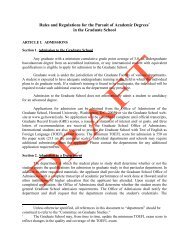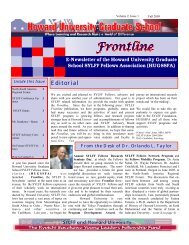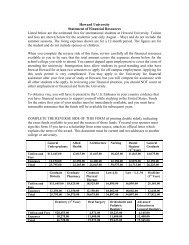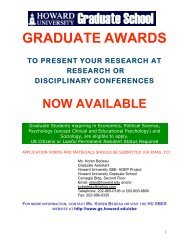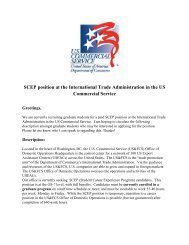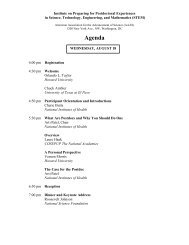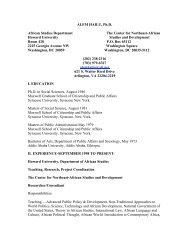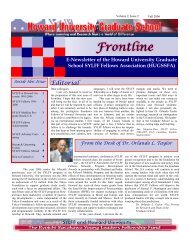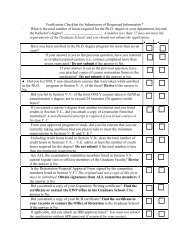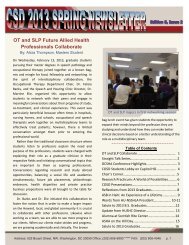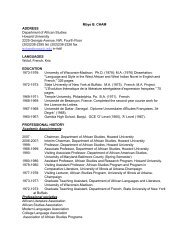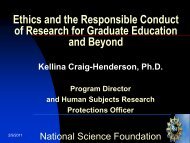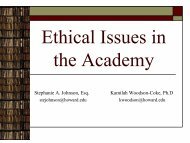Self-Study Design - Howard University, Graduate School
Self-Study Design - Howard University, Graduate School
Self-Study Design - Howard University, Graduate School
Create successful ePaper yourself
Turn your PDF publications into a flip-book with our unique Google optimized e-Paper software.
<strong>University</strong> aspires to advance to Carnegie’s Highest Research Activity category among the<br />
nation’s research universities. Indeed, the <strong>University</strong> has established a goal of exceeding $100<br />
million of extramural research activity by 2010.<br />
Similarly, <strong>Howard</strong> seeks to advance to the First Tier among National Research Universities in<br />
the aforementioned national publications and advance all of its academic disciplines to at least<br />
the top half in relation to their peers at other research universities and to increase the number of<br />
niche areas that rank in the upper echelon of their disciplines.<br />
An effort has been made to establish benchmarks for <strong>Howard</strong> to compare itself with other<br />
research universities of comparable size with medical and engineering schools. In this regard, for<br />
purposes of the <strong>Self</strong>-<strong>Study</strong>, an informal process was conducted internally to obtain broad<br />
university community input relative to a possible list of peer/aspirational institutions against<br />
which <strong>Howard</strong> might compare itself with respect to the quality of its academic programs; the<br />
allocation of its resources; and the effectiveness of its policies, practices, and systems. Although<br />
more than 30 institutions were recommended for consideration, the following 10 institutions<br />
were selected by the Steering Committee for use by the Work Groups for benchmark purposes:<br />
Case Western Reserve <strong>University</strong>, Emory <strong>University</strong>, George Washington <strong>University</strong>,<br />
Georgetown <strong>University</strong>, Saint Louis <strong>University</strong>, Temple <strong>University</strong>, Tulane <strong>University</strong>, the<br />
<strong>University</strong> of Maryland–College Park, Vanderbilt <strong>University</strong>, and Washington <strong>University</strong> in<br />
Saint Louis. 1<br />
While <strong>Howard</strong> <strong>University</strong> aspires to compete with the nation’s leading research universities, it<br />
remains mindful, nonetheless, that it must also compete assiduously for the nation’s best<br />
African-American undergraduate students with many liberal arts and master’s focused<br />
institutions. In particular, <strong>Howard</strong> competes with the nation’s leading HBCUs, such as Hampton<br />
<strong>University</strong>, Morehouse College, and Spelman College for talented, African-American<br />
undergraduate students.<br />
The <strong>Self</strong>-<strong>Study</strong> Scope of Work and Context<br />
The <strong>Self</strong>-<strong>Study</strong> will be of the comprehensive model as defined by the Middle States Commission<br />
on Higher Education’s <strong>Self</strong>-<strong>Study</strong>: Creating a Useful Process and Report, with additionally<br />
focused attention to the area of research. Because the <strong>University</strong> is in a transition period that will<br />
result in the appointment of a new president in 2008, the comprehensive model appears to be the<br />
most appropriate one for the <strong>University</strong> to use at this time in assessing the effectiveness of the<br />
policies and practices that undergird its systems and operations.<br />
The <strong>University</strong> has chosen also to conduct a thorough and focused look at its research enterprise.<br />
It will specifically examine its infrastructure for supporting extramurally funded research; the<br />
reward system for faculty to conduct research and obtain grants and contracts to support<br />
research; the allocation of funds to support faculty and student research; and the extent to which<br />
1 In the 1999 <strong>Self</strong>-<strong>Study</strong>, the following ten institutions were used as peer institutions: Emory <strong>University</strong>,<br />
Georgetown <strong>University</strong>, St. John’s <strong>University</strong>, Temple <strong>University</strong>, Tulane <strong>University</strong>, Vanderbilt <strong>University</strong>,<br />
<strong>University</strong> of Cincinnati, <strong>University</strong> of Maryland, <strong>University</strong> of Miami, and <strong>University</strong> of Virginia.<br />
10



